A Deep Dive: Analysis on Play and Playfulness in Early Learning
VerifiedAdded on 2022/08/16
|6
|1419
|8
Essay
AI Summary
This essay provides an in-depth analysis of the concepts of play and playfulness within the context of early childhood education, drawing on four selected articles to explore the relationship between play, curriculum frameworks, and child development. The analysis examines how play allows children to explore their capabilities, express themselves, and develop cognitive skills. The essay delves into the role of educators in guiding children's play, fostering language development, and promoting social and moral responsibilities. It highlights the importance of free play, adult intervention strategies, and the child's right to engage in playful activities. The conclusion emphasizes the essential role of educators in shaping children's cognitive, communication, and decision-making abilities through the effective implementation of play and playfulness models.
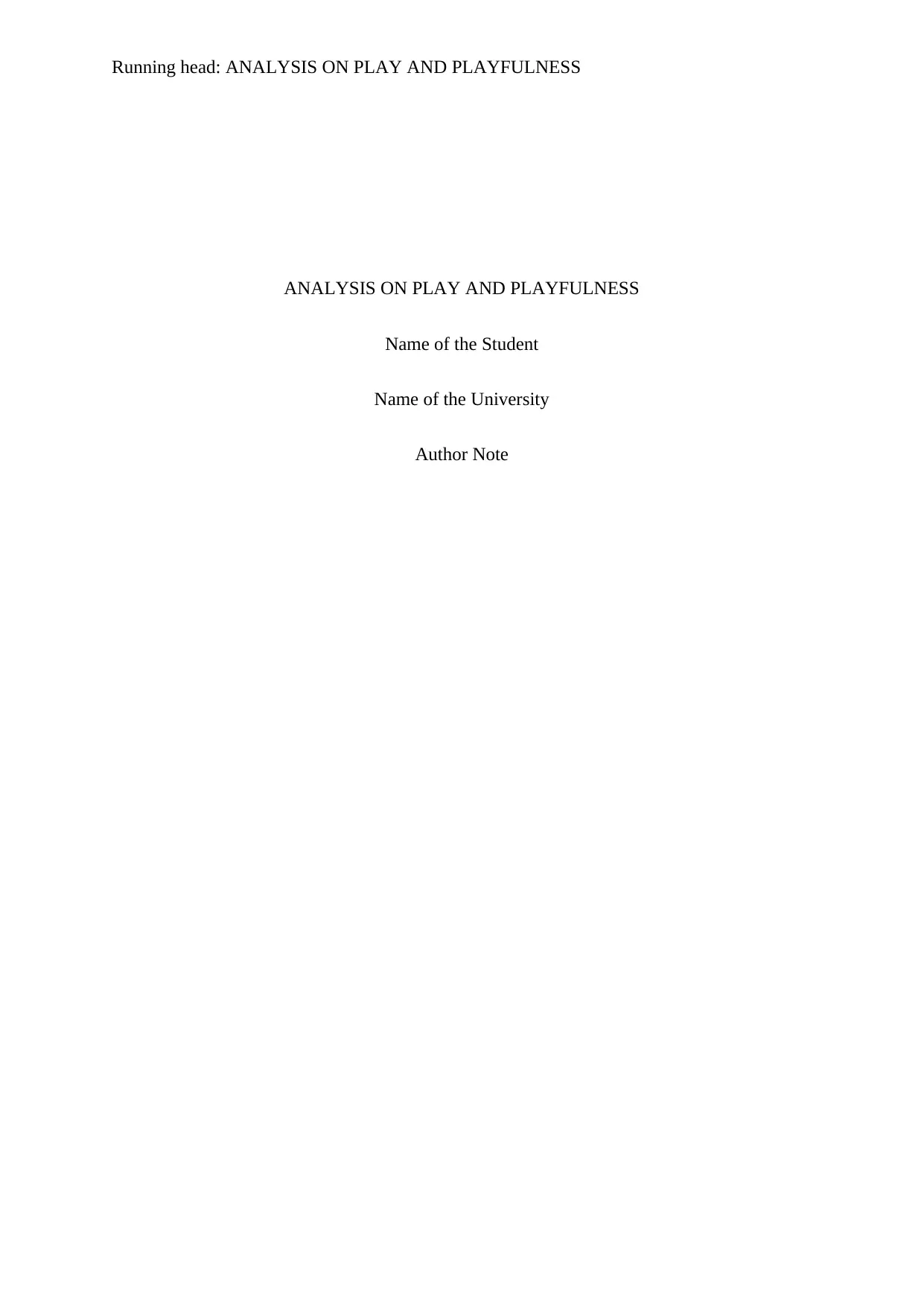
Running head: ANALYSIS ON PLAY AND PLAYFULNESS
ANALYSIS ON PLAY AND PLAYFULNESS
Name of the Student
Name of the University
Author Note
ANALYSIS ON PLAY AND PLAYFULNESS
Name of the Student
Name of the University
Author Note
Secure Best Marks with AI Grader
Need help grading? Try our AI Grader for instant feedback on your assignments.
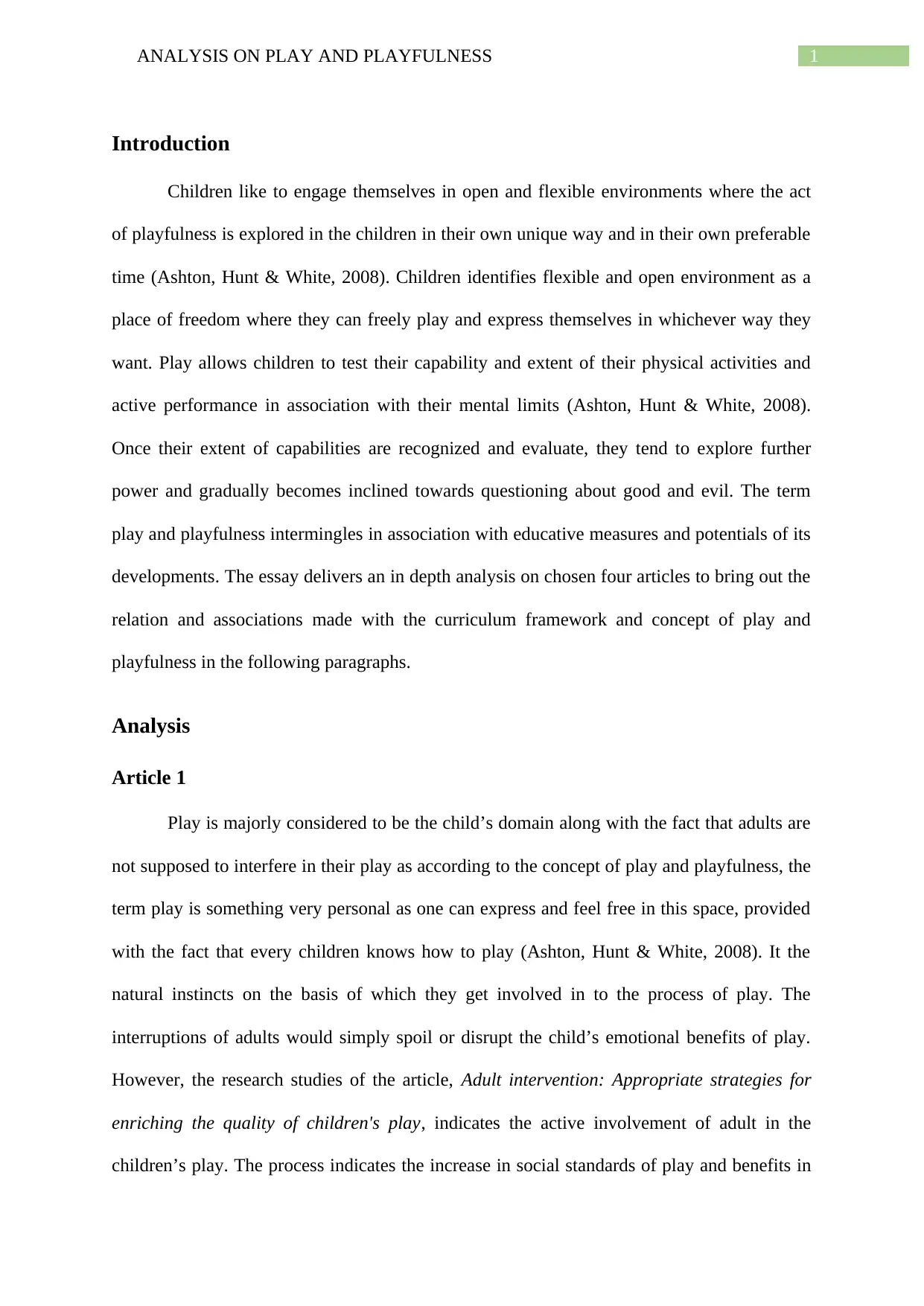
1ANALYSIS ON PLAY AND PLAYFULNESS
Introduction
Children like to engage themselves in open and flexible environments where the act
of playfulness is explored in the children in their own unique way and in their own preferable
time (Ashton, Hunt & White, 2008). Children identifies flexible and open environment as a
place of freedom where they can freely play and express themselves in whichever way they
want. Play allows children to test their capability and extent of their physical activities and
active performance in association with their mental limits (Ashton, Hunt & White, 2008).
Once their extent of capabilities are recognized and evaluate, they tend to explore further
power and gradually becomes inclined towards questioning about good and evil. The term
play and playfulness intermingles in association with educative measures and potentials of its
developments. The essay delivers an in depth analysis on chosen four articles to bring out the
relation and associations made with the curriculum framework and concept of play and
playfulness in the following paragraphs.
Analysis
Article 1
Play is majorly considered to be the child’s domain along with the fact that adults are
not supposed to interfere in their play as according to the concept of play and playfulness, the
term play is something very personal as one can express and feel free in this space, provided
with the fact that every children knows how to play (Ashton, Hunt & White, 2008). It the
natural instincts on the basis of which they get involved in to the process of play. The
interruptions of adults would simply spoil or disrupt the child’s emotional benefits of play.
However, the research studies of the article, Adult intervention: Appropriate strategies for
enriching the quality of children's play, indicates the active involvement of adult in the
children’s play. The process indicates the increase in social standards of play and benefits in
Introduction
Children like to engage themselves in open and flexible environments where the act
of playfulness is explored in the children in their own unique way and in their own preferable
time (Ashton, Hunt & White, 2008). Children identifies flexible and open environment as a
place of freedom where they can freely play and express themselves in whichever way they
want. Play allows children to test their capability and extent of their physical activities and
active performance in association with their mental limits (Ashton, Hunt & White, 2008).
Once their extent of capabilities are recognized and evaluate, they tend to explore further
power and gradually becomes inclined towards questioning about good and evil. The term
play and playfulness intermingles in association with educative measures and potentials of its
developments. The essay delivers an in depth analysis on chosen four articles to bring out the
relation and associations made with the curriculum framework and concept of play and
playfulness in the following paragraphs.
Analysis
Article 1
Play is majorly considered to be the child’s domain along with the fact that adults are
not supposed to interfere in their play as according to the concept of play and playfulness, the
term play is something very personal as one can express and feel free in this space, provided
with the fact that every children knows how to play (Ashton, Hunt & White, 2008). It the
natural instincts on the basis of which they get involved in to the process of play. The
interruptions of adults would simply spoil or disrupt the child’s emotional benefits of play.
However, the research studies of the article, Adult intervention: Appropriate strategies for
enriching the quality of children's play, indicates the active involvement of adult in the
children’s play. The process indicates the increase in social standards of play and benefits in
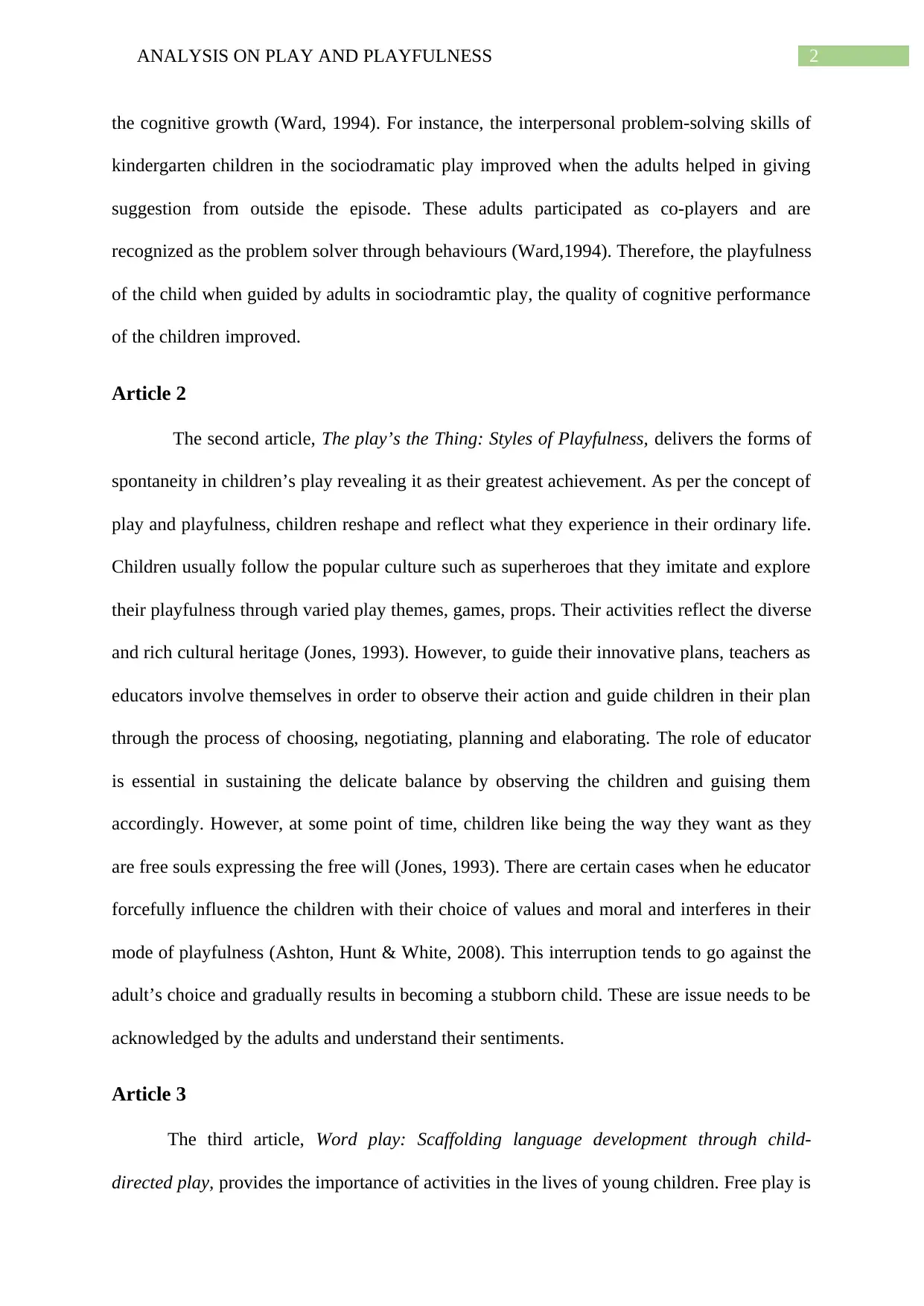
2ANALYSIS ON PLAY AND PLAYFULNESS
the cognitive growth (Ward, 1994). For instance, the interpersonal problem-solving skills of
kindergarten children in the sociodramatic play improved when the adults helped in giving
suggestion from outside the episode. These adults participated as co-players and are
recognized as the problem solver through behaviours (Ward,1994). Therefore, the playfulness
of the child when guided by adults in sociodramtic play, the quality of cognitive performance
of the children improved.
Article 2
The second article, The play’s the Thing: Styles of Playfulness, delivers the forms of
spontaneity in children’s play revealing it as their greatest achievement. As per the concept of
play and playfulness, children reshape and reflect what they experience in their ordinary life.
Children usually follow the popular culture such as superheroes that they imitate and explore
their playfulness through varied play themes, games, props. Their activities reflect the diverse
and rich cultural heritage (Jones, 1993). However, to guide their innovative plans, teachers as
educators involve themselves in order to observe their action and guide children in their plan
through the process of choosing, negotiating, planning and elaborating. The role of educator
is essential in sustaining the delicate balance by observing the children and guising them
accordingly. However, at some point of time, children like being the way they want as they
are free souls expressing the free will (Jones, 1993). There are certain cases when he educator
forcefully influence the children with their choice of values and moral and interferes in their
mode of playfulness (Ashton, Hunt & White, 2008). This interruption tends to go against the
adult’s choice and gradually results in becoming a stubborn child. These are issue needs to be
acknowledged by the adults and understand their sentiments.
Article 3
The third article, Word play: Scaffolding language development through child-
directed play, provides the importance of activities in the lives of young children. Free play is
the cognitive growth (Ward, 1994). For instance, the interpersonal problem-solving skills of
kindergarten children in the sociodramatic play improved when the adults helped in giving
suggestion from outside the episode. These adults participated as co-players and are
recognized as the problem solver through behaviours (Ward,1994). Therefore, the playfulness
of the child when guided by adults in sociodramtic play, the quality of cognitive performance
of the children improved.
Article 2
The second article, The play’s the Thing: Styles of Playfulness, delivers the forms of
spontaneity in children’s play revealing it as their greatest achievement. As per the concept of
play and playfulness, children reshape and reflect what they experience in their ordinary life.
Children usually follow the popular culture such as superheroes that they imitate and explore
their playfulness through varied play themes, games, props. Their activities reflect the diverse
and rich cultural heritage (Jones, 1993). However, to guide their innovative plans, teachers as
educators involve themselves in order to observe their action and guide children in their plan
through the process of choosing, negotiating, planning and elaborating. The role of educator
is essential in sustaining the delicate balance by observing the children and guising them
accordingly. However, at some point of time, children like being the way they want as they
are free souls expressing the free will (Jones, 1993). There are certain cases when he educator
forcefully influence the children with their choice of values and moral and interferes in their
mode of playfulness (Ashton, Hunt & White, 2008). This interruption tends to go against the
adult’s choice and gradually results in becoming a stubborn child. These are issue needs to be
acknowledged by the adults and understand their sentiments.
Article 3
The third article, Word play: Scaffolding language development through child-
directed play, provides the importance of activities in the lives of young children. Free play is
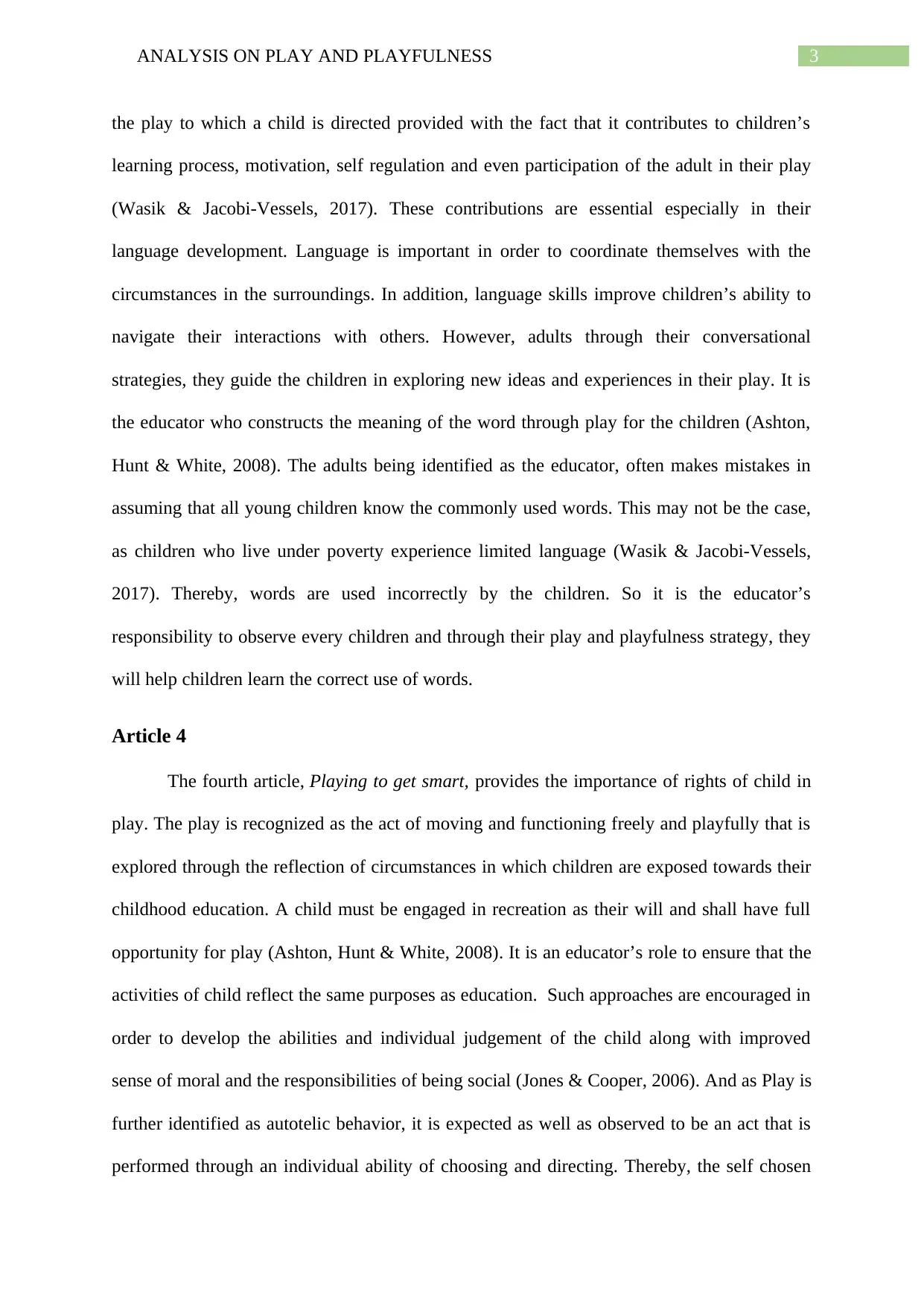
3ANALYSIS ON PLAY AND PLAYFULNESS
the play to which a child is directed provided with the fact that it contributes to children’s
learning process, motivation, self regulation and even participation of the adult in their play
(Wasik & Jacobi-Vessels, 2017). These contributions are essential especially in their
language development. Language is important in order to coordinate themselves with the
circumstances in the surroundings. In addition, language skills improve children’s ability to
navigate their interactions with others. However, adults through their conversational
strategies, they guide the children in exploring new ideas and experiences in their play. It is
the educator who constructs the meaning of the word through play for the children (Ashton,
Hunt & White, 2008). The adults being identified as the educator, often makes mistakes in
assuming that all young children know the commonly used words. This may not be the case,
as children who live under poverty experience limited language (Wasik & Jacobi-Vessels,
2017). Thereby, words are used incorrectly by the children. So it is the educator’s
responsibility to observe every children and through their play and playfulness strategy, they
will help children learn the correct use of words.
Article 4
The fourth article, Playing to get smart, provides the importance of rights of child in
play. The play is recognized as the act of moving and functioning freely and playfully that is
explored through the reflection of circumstances in which children are exposed towards their
childhood education. A child must be engaged in recreation as their will and shall have full
opportunity for play (Ashton, Hunt & White, 2008). It is an educator’s role to ensure that the
activities of child reflect the same purposes as education. Such approaches are encouraged in
order to develop the abilities and individual judgement of the child along with improved
sense of moral and the responsibilities of being social (Jones & Cooper, 2006). And as Play is
further identified as autotelic behavior, it is expected as well as observed to be an act that is
performed through an individual ability of choosing and directing. Thereby, the self chosen
the play to which a child is directed provided with the fact that it contributes to children’s
learning process, motivation, self regulation and even participation of the adult in their play
(Wasik & Jacobi-Vessels, 2017). These contributions are essential especially in their
language development. Language is important in order to coordinate themselves with the
circumstances in the surroundings. In addition, language skills improve children’s ability to
navigate their interactions with others. However, adults through their conversational
strategies, they guide the children in exploring new ideas and experiences in their play. It is
the educator who constructs the meaning of the word through play for the children (Ashton,
Hunt & White, 2008). The adults being identified as the educator, often makes mistakes in
assuming that all young children know the commonly used words. This may not be the case,
as children who live under poverty experience limited language (Wasik & Jacobi-Vessels,
2017). Thereby, words are used incorrectly by the children. So it is the educator’s
responsibility to observe every children and through their play and playfulness strategy, they
will help children learn the correct use of words.
Article 4
The fourth article, Playing to get smart, provides the importance of rights of child in
play. The play is recognized as the act of moving and functioning freely and playfully that is
explored through the reflection of circumstances in which children are exposed towards their
childhood education. A child must be engaged in recreation as their will and shall have full
opportunity for play (Ashton, Hunt & White, 2008). It is an educator’s role to ensure that the
activities of child reflect the same purposes as education. Such approaches are encouraged in
order to develop the abilities and individual judgement of the child along with improved
sense of moral and the responsibilities of being social (Jones & Cooper, 2006). And as Play is
further identified as autotelic behavior, it is expected as well as observed to be an act that is
performed through an individual ability of choosing and directing. Thereby, the self chosen
Secure Best Marks with AI Grader
Need help grading? Try our AI Grader for instant feedback on your assignments.
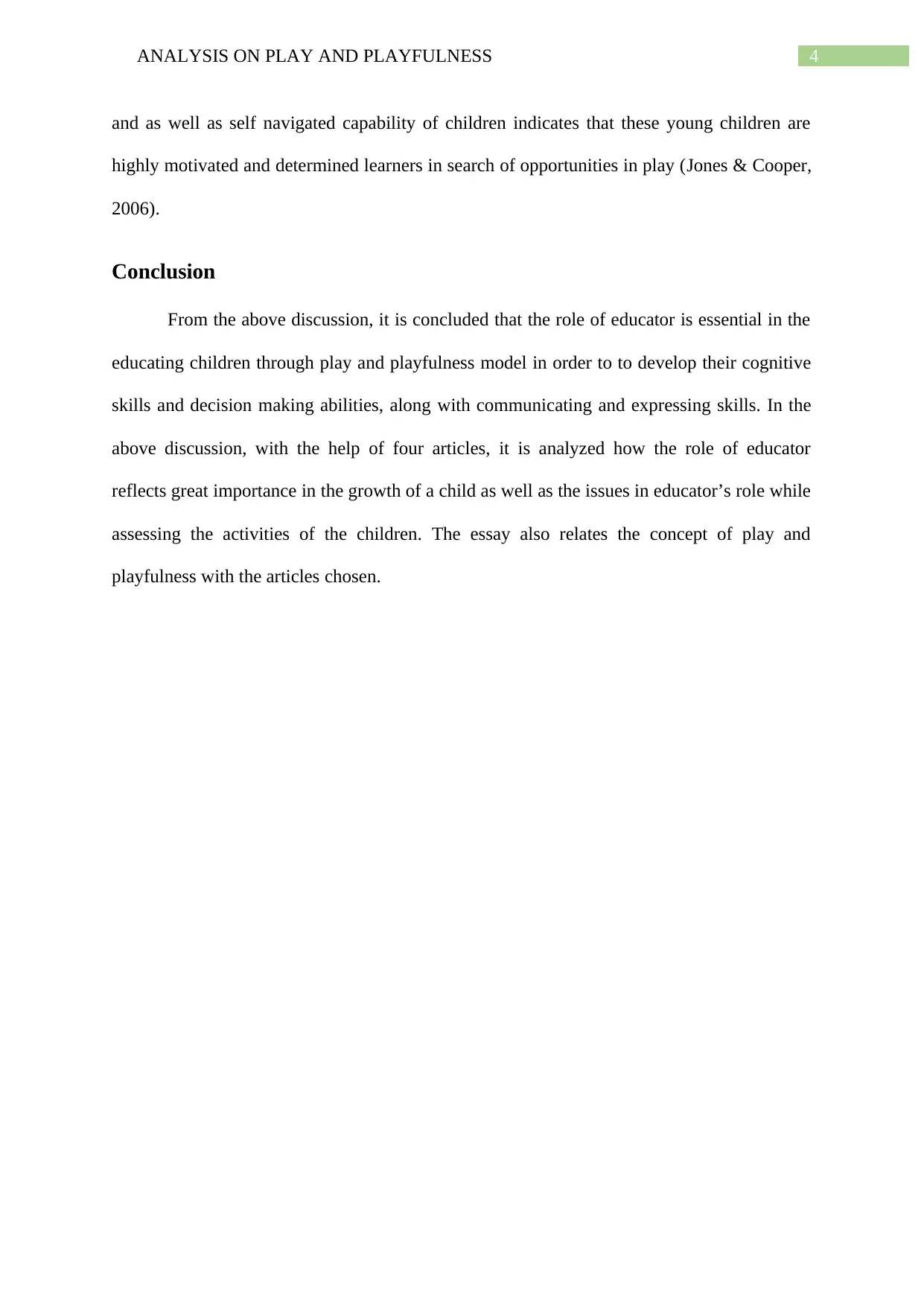
4ANALYSIS ON PLAY AND PLAYFULNESS
and as well as self navigated capability of children indicates that these young children are
highly motivated and determined learners in search of opportunities in play (Jones & Cooper,
2006).
Conclusion
From the above discussion, it is concluded that the role of educator is essential in the
educating children through play and playfulness model in order to to develop their cognitive
skills and decision making abilities, along with communicating and expressing skills. In the
above discussion, with the help of four articles, it is analyzed how the role of educator
reflects great importance in the growth of a child as well as the issues in educator’s role while
assessing the activities of the children. The essay also relates the concept of play and
playfulness with the articles chosen.
and as well as self navigated capability of children indicates that these young children are
highly motivated and determined learners in search of opportunities in play (Jones & Cooper,
2006).
Conclusion
From the above discussion, it is concluded that the role of educator is essential in the
educating children through play and playfulness model in order to to develop their cognitive
skills and decision making abilities, along with communicating and expressing skills. In the
above discussion, with the help of four articles, it is analyzed how the role of educator
reflects great importance in the growth of a child as well as the issues in educator’s role while
assessing the activities of the children. The essay also relates the concept of play and
playfulness with the articles chosen.
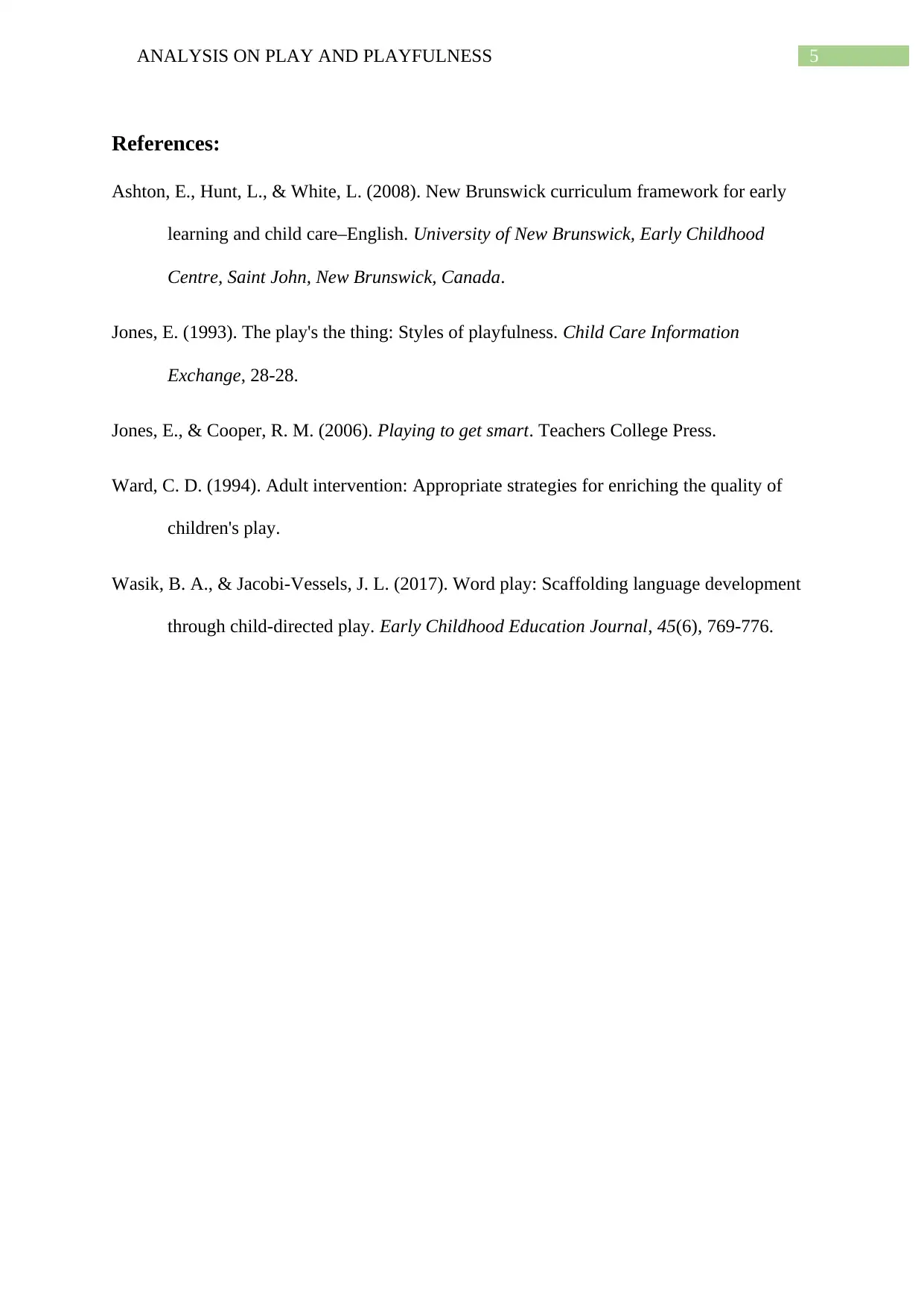
5ANALYSIS ON PLAY AND PLAYFULNESS
References:
Ashton, E., Hunt, L., & White, L. (2008). New Brunswick curriculum framework for early
learning and child care–English. University of New Brunswick, Early Childhood
Centre, Saint John, New Brunswick, Canada.
Jones, E. (1993). The play's the thing: Styles of playfulness. Child Care Information
Exchange, 28-28.
Jones, E., & Cooper, R. M. (2006). Playing to get smart. Teachers College Press.
Ward, C. D. (1994). Adult intervention: Appropriate strategies for enriching the quality of
children's play.
Wasik, B. A., & Jacobi-Vessels, J. L. (2017). Word play: Scaffolding language development
through child-directed play. Early Childhood Education Journal, 45(6), 769-776.
References:
Ashton, E., Hunt, L., & White, L. (2008). New Brunswick curriculum framework for early
learning and child care–English. University of New Brunswick, Early Childhood
Centre, Saint John, New Brunswick, Canada.
Jones, E. (1993). The play's the thing: Styles of playfulness. Child Care Information
Exchange, 28-28.
Jones, E., & Cooper, R. M. (2006). Playing to get smart. Teachers College Press.
Ward, C. D. (1994). Adult intervention: Appropriate strategies for enriching the quality of
children's play.
Wasik, B. A., & Jacobi-Vessels, J. L. (2017). Word play: Scaffolding language development
through child-directed play. Early Childhood Education Journal, 45(6), 769-776.
1 out of 6
Your All-in-One AI-Powered Toolkit for Academic Success.
+13062052269
info@desklib.com
Available 24*7 on WhatsApp / Email
![[object Object]](/_next/static/media/star-bottom.7253800d.svg)
Unlock your academic potential
© 2024 | Zucol Services PVT LTD | All rights reserved.